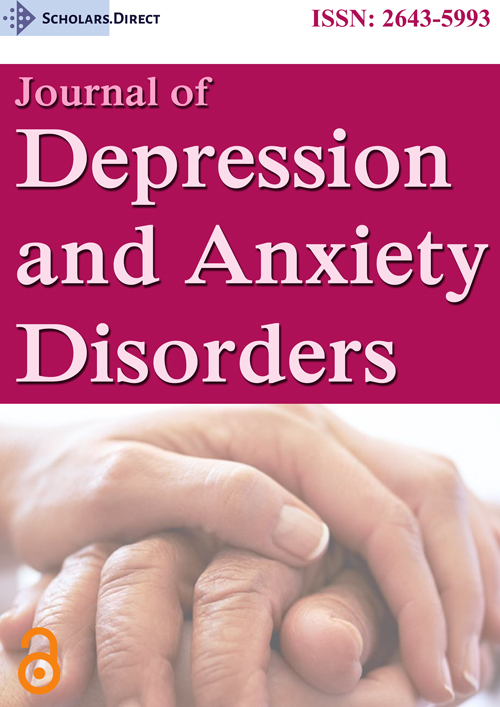Effects of ELF-EMF Treatment on Depression
Abstract
Introduction: Depression is an extremely widespread disorder that is also highly impactful on the quality of life and general health of individuals, on a global scale.
The aim of this study was a preliminary assessment of a potential non-pharmacological treatment, based on extremely low frequency and intensity electromagnetic fields (ELF-EMF), which could potentially reduce the impact of depression on the lives of sufferers.
Materials and methods: A preliminary case-control study based in 2centres was conducted during the second half of 2020.
The recruited participants were subject either to ELF-EMF treatment (Group α) or to a placebo treatment (Group β) for a total of 5 sessions. Treatment involved non-focused exposure using a radiant mat associated with focused exposure in the cranial area using the same ELF-EMF parameters. Each individual session lasted 36 min and the same ELF-EMF program was used for all 5 therapeutic sessions. The effects of treatment were evaluated by giving the subjects the following self-administration tests: Zung Self-Rating Depression Scale (SDS), Beck Depression Inventory Scale (BDI), and Short-Form 12 (SF12). The tests were administered before starting the treatment cycle (T0), after the 5 sessions (T1), and at a 2 month follow-up (FU).
Results: Statistical significance indicating an improvement in the depressed state perceived by the participants was achieved with both the SDS and the BDI, at T1 (T1: SDSα 37.8, SDSβ 46.6, p = 0.012; BDIα 8.7, BDIβ 20.4, p = 0.004) and persisting at FU (T1: SDSα 39.1, SDSβ 49, p = 0.037; BDIα 10, BDIβ 19.9, p = 0.04).
As regards SF12, the mental part of the test (MCS12) exhibited a significant improvement at T1in the treated group compared to the placebo (MCS12α 47.40, MCS12β 40.48, p = 0.048), but this was not confirmed at FU.
During the treatment period there were no drop-outs from the 2 groups and no adverse events were reported in the treatment group.
Conclusions: Treatment with ELF-EMF demonstrated safety and efficacy for reducing the gravity of perceived depressed state.
Introduction
Depression is possibly the most widespread psychiatric disorder in the world, affecting more than 264 million people, according to an online report by the WHO in January 2020 (https://www.who.int/news-room/fact-sheets/detail/depression).
Electromagnetic fields are widely used today in psychiatry, based on transcranial magnetic stimulation technology (TMS) [1-3]. This is also applicable in the treatment of depression [4,5].
However, the use of extremely low frequency and intensity electromagnetic fields, so-called ELF-EMF, in psychology and psychiatry has been little studied. These could reduce the risk of undesirable effects associated with the higher intensities administered during TMS.
It is known that depression involves an alteration in serotonin metabolism (5-HT) and of the serotoninergic circuits [6-8]. Recent observations have demonstrated how these alterations are strongly linked to inflammation [9], thus defining depression as a systemic disorder.
It is equally well known that depressed subject’s present altered brain electrical activity [10].
Current knowledge of the application of ELF-EMF in biology, though limited, includes a well documented systemic anti-inflammatory effect [11-19]. The effects of ELF-EMF on the 5-HT metabolism [20,21] are also well known. Finally, it has been demonstrated that brain electrical activity can be influenced by the application of ELF-EMF [22], with frequency dependent effects [23].
Starting from this state-of-art, the authors wanted to investigate whether the abovementioned effects of ELF-EMF might have a positive impact on depressed subjects.
Materials and Methods
This double-blind case-control study was carried out at two distinct centres: The Poliambulatorio C.F.M. medical physiotherapy centre located in Treviglio (BG, Italy), and an integrated medicine day clinic at the Public Agency for Personal Health Services (APSP, old age home) "Santa Maria", located in Cles (TN, Italy).
Twenty participants were recruited for the study with diagnoses of depression, evaluated on 2 dedicated scales: Zung’s Self-Rating Depression Scale (ZSDS), and Beck's Depression Inventory (BDI). In addition to these scales, a more generic self-assessment was included using the SF-12. The scales were measured before start (T0), and at termination (T1), of the treatment cycle, which included 5 sessions. Four weeks after completion of treatment the scales were measured again as a follow-up evaluation (FU).
The 20 subjects were divided equally between the two centres cited above: 10 in Group α (treated) and 10 in Group β (placebo). The results were then analysed statistically applying Student's t-distribution analysis at 95% confidence.
Zung’s self-rating depression scale (ZSDS) [24-26]
The ZSDS is a questionnaire designed to assess the quantitative aspects of depression. It comprises 20 items that investigate physiological symptoms and concomitant psychological symptoms of the depressive syndrome. This widely used questionnaire was first published in 1965 and revised in 1974 as an auxiliary instrument in clinical diagnosis, as well as an epidemiological research instrument, and for measuring the efficacy of psychotherapeutic and/or pharmacological treatments.
Beck's depression inventory (BDI) [27-29]
This scale was created to measure the behavioural expression of depression. Its main characteristic is that the quantification criteria are clearly defined for every item: Each level of seriousness has a specific definition, from which patients choose the one best describing their own condition.
SF-12 Quality of life assessment [30-32]
The SF-12 questionnaire is anabridged version of the Short-Form Health Survey 36 (SF-36). It uses 12 of the 36 questions of the original questionnaire to investigate just the 2 summary indices rather than the original 8 scales. The two indices are the PCS (Physical Component Summary) for physical state, and the MCS (Mental Component Summary) for mental state. The main strong points of this questionnaire are its conciseness and relative ease of use.
SEQEX devices
This study involved the use of a SEQEX® device, produced and distributed by the Italian company S.I.S.S.T.E.M.I. Srl (Trento, Italy), certified CSQ ISO-13485. This device implements an analogue mechanism to generate complex electromagnetic fields in a frequency range from 1 to 124 Hz, of variable intensity from 1 to 20 µT. The field parameters are tested by the manufacturing company using specialized instrumentation: A GM08 Gauss meter produced by the company Hirst.
The electromagnetic fields produced by the control unit of the treatment device (on which the electromagnetic field parameters are set) are administered from a mat containing Helmholtz coils that generate the ELF-EMF. Patients lie on the mat and receive non-focused total-body treatment with weak electromagnetic fields.
This study made use of two device variants, one fully functional and the other modified so that no form of electromagnetic field was emitted. One device was located in each of the two centres taking part in the study (Table 1).
"Time on" represents the period in seconds during which the device effectively emits ELF-EMF. "Time off" represents the period in seconds during which the device does not emit anything. During each step time (indicated as "Total time") the ELF-EMF is administered following the time on/time off cycle.
The ELF-EMF as described in the table was administered to patients simultaneously in two different ways: Using a radiant mat for non-focused total-body treatment, and using a band accessory positioned on each patient's cranium.
Results
ZSDS
The results at T0 for both Group α and Group β were substantially equivalent (average α = 48.6, average β = 48) (Table 2).
At T1, Group α showed a significant reduction in test-score compared to Group β (average α = 37.8, average β = 46.6, p = 0.0121).
At FU, the difference in scores between the two groups remained statistically significant (average α = 39.1, average β = 49, p = 0.0374).
BDI
The results at T0 for both Group α and Group β were substantially equivalent (average α = 21.3, average β = 22) (Table 3).
At T1, Group α showed a significant reduction in test-score compared to Group β (average α = 8.7, average β = 20.4, p = 0.0039).
At FU, the difference in scores between the two groups remained statistically significant (average α = 10, average β = 19.9, p = 0.0429).
SF-12
The results at T0 for both Group α and Group β were substantially equivalent (average α = 41.28, average β = 41.21) (Table 4 and Table 5).
At T1, Group α showed a significant increase in test-score compared to Group β (average α = 47.40, average β = 40.48, p = 0.0486).
At FU, the difference in scores between the two groups had lost the statistical significance observed at end of treatment (average α = 42.81, average β = 41.73).
Discussion
The effect of ELF-EMF on the central nervous system (CNS) and in particular on the psycho affective component has been widely documented in literature [1-5].
Two independent studies conducted using the same devices as the present study observed a positive effect of non-focused ELF-EMF treatment:
• Betti, et al. [33] verified an absence of adverse effects and concomitant positive response (measured on the BPRS scale) for psychiatric patients.
• Greco and Garoli [23] conducted electroencephalographic analysis of healthy subjects undergoing non-focused ELF-EMF treatment that simulated cerebral frequencies and rhythms, obtaining an initial observation of the adaptive behaviour of the CNS in response to electromagnetic stimulation.
In addition, a study by Greco and Destefani [34] verified the effects of non-focused electromagnetic fields on heart rate variability (and so indirectly on the autonomic nervous system).
Starting from these premises, the present authors adopted a hybrid set-up that combined non-focused total-body treatment, with direct stimulation on the cranium of patients. Both electromagnetic irradiation sources administered the same extremely low frequency and intensity electromagnetic field, as described in the "Materials and Methods".
The frequencies selected for this trial were based on one of the set-ups used in the study by Greco and Garoli [23], specifically called the "Alpha" set-up.
In this study the authors decided to focus on two specific scales for depression, together with a test specific to quality of life.
The 10 subjects exposed to ELF-EMF treatment (Group α) experienced an objective improvement in depressed state compared to the control (Group β), with an improved outcome on both the ZDS scale (p = 0.0121) and BDI scale (p = 0.0039) at the end of the treatment cycle, with statistically significant scores persisting at FU (ZDS p = 0.0374, BDI p = 0.0429).
The results from the generic SF-12 test were somewhat different. As predicted at T0, the homogeneity of the 2 test groups resulted in the PCS12 component showing no significant variations on the measurement scales. MCS12 instead showed a significant difference in favour of the treatment group at T1 (p = 0.0486), but this was not confirmed at FU. This final detail does not compromise the results obtained for the two depression specific tests, since the MCS12 is highly generic in nature, causing it to vary (also in a negative sense) for reasons extraneous to the object of study in this paper (for example, a wrist fracture, or a week of flu, can alter an MCS12 score enough to change in outcome, but without influencing other tests so strongly).
Depression is among the diseases that most negatively effect quality of life [35-38], also acting as an unfavourable prognostic factor for cardiac diseases [39-42] and chronic diseases [43-45] if not effectively treated. Consequently, acting to mitigate this disability is a priority for sufferers, therapists, and from the perspective of public health.
Starting from the etiogenesis of depressive disorders [6-10] and the effects of pharmaceuticals like selective serotonin reuptake inhibitors (SSRIs) [46-48] and considering the effects of ELF-EMF studied to date on the 5-HT metabolism [20,21], on the 5-HTreceptors (5-HTRs) [49], and brain electrical activity [22,23], the authors propose the following hypothesis for the action of ELF-EMF on depression:
• The combination of focused and non-focused ELF-EMF irradiation stimulates production of 5-HT in the encephalic trunk, a component that plays an important role in the pathophysiology of depression [50].
• The 5-HTRs most likely involved in the antidepressant effect associated with ELF-EMF are the 5HT1 (supporting the previous point) and cortical 5HT2 receptors, with the effect of enhanced receptor density.
• The induction of specific frequency dependent electrical activity [23] with in the 10-12Hz range also induces an increase of 5-HT production in the cortex.
• Considering the action on the metabolism of dopamine [20], the involvement of the dopaminergic circuits linked to depression can also not be excluded.
• The effects described in the previous points appear to stabilize after a brief treatment cycle, inducing effects that endure for as long as several weeks. This could be explained with a direct action on the HRV [34], a biomarker for potential response to antidepressant therapy [51].
• The anti-inflammatory and neuroprotective effects of ELF-EMF [52] could further explain the effect, especially with such rapid treatment response times, bearing in mind the pathophysiological gravity of neuroinflammation on the genesis of depression.
Since the administration of ELF-EMF was not focused on a single cranial target, it is difficult to establish the robustness of the above hypotheses. It is possible that multiple phenomena occur in combination, with enhanced induction under specific frequencies and a summation effect.
Conclusions
While the study presented here is conditioned by some obvious limitations (among others, the small number of recruited participants), the authors nevertheless sustain that the approach presented for the treatment of depressive disorders, in addition to being safe, may prove to be valid both as a stand-alone approach, and as a support for pharmacological antidepressant therapies and psychotherapy within integrated medicine protocols.
The authors are convinced that the hypotheses formulated here deserve further investigation, including an amplification of the breadth of enquiry into the effects of ELF-EMF on the central nervous system.
Statement of Conflict of Interest
Dr. Alessandro Greco declares that he is an external consultant for the company S.I.S.T.E.M.I. srl, acting in the roles of: Medical and scientific director for training professional therapists in the use of the device adopted for the present study, development of new technologies, and researching new therapeutic applications for the technologies applied in the present paper.
References
- Gorelick DA, Zangen A, George MS (2014) Transcranial magnetic stimulation in the treatment of substance addiction. Ann N Y Acad Sci 1327: 79-93.
- Dougall N, Maayan N, Soares-Weiser K, et al. (2015) Transcranial magnetic stimulation for schizophrenia. Schizophr Bull 41: 1220-1222.
- Narayana S, Papanicolaou AC, McGregor A, et al. (2015) Clinical applications of transcranial magnetic stimulation in pediatric neurology. J Child Neurol 30: 1111-1124.
- Sonmez AI, Camsari DD, Nandakumar AL, et al. (2019) Accelerated TMS for depression: A systematic review and meta-analysis. Psychiatry Res 273: 770-781.
- Perera T, George MS, Grammer G, et al. (2016) The clinical TMS society consensus review and treatment recommendations for TMS therapy for major depressive disorder. Brain Stimul 9: 336-346.
- Yuan TF, Paes F, Arias-Carrion O, et al. (2015) Neural mechanisms of exercise: Anti-Depression, neurogenesis, and serotonin signaling. CNS Neurol Disord Drug Targets 14: 1307-1311.
- Daut RA, Fonken LK (2019) Circadian regulation of depression: A role for serotonin. Front Neuroendocrinol 54: 100746.
- Kraus C, Castren E, Kasper S, et al. (2017) Serotonin and neuroplasticity - Links between molecular, functional and structural pathophysiology in depression. Neurosci Biobehav Rev 77: 317-326.
- Dell'Osso L, Carmassi C, Mucci F, et al. (2016) Depression, serotonin and tryptophan. Curr Pharm Des 22: 949-954.
- de Aguiar Neto FS, Rosa JLG (2019) Depression biomarkers using non-invasive EEG: A review. Neurosci Biobehav Rev 105: 83-93.
- Patruno A, Tabrez S, Pesce M, et al. (2015) Effects of extremely low frequency electromagnetic field (ELF-EMF) on catalase, cytochrome P450 and nitric oxide synthase in erythro-leukemic cells. Life Sci 121: 117-123.
- Varani K, Vincenzi F, Ravani A, et al. (2017) Adenosine receptors as a biological pathway for the anti-inflammatory and beneficial effects of low frequency low energy pulsed electromagnetic fields. Mediators Inflamm 2017: 2740963.
- Vianale G, Reale M, Amerio P, et al. (2008) Extremely low frequency electromagnetic field enhances human keratinocyte cell growth and decreases proinflammatory chemokine production. Br J Dermatol 158: 1189-1196.
- Ross CL, Teli T, Harrison BS (2016) Electromagnetic Field Devices and Their Effects on Nociception and Peripheral Inflammatory Pain Mechanisms. Altern Ther Health Med 22: 52-64.
- Zou J, Chen Y, Qian J, et al. (2017) Effect of a low-frequency pulsed electromagnetic field on expression and secretion of IL-1β and TNF-α in nucleus pulposus cells. J Int Med Res 45: 462-470.
- Ross CL, Harrison BS (2013) Effect of time-varied magnetic field on inflammatory response in macrophage cell line RAW 264.7. Electromagnetic Biol Med 32: 59-69.
- Mahaki H, Jabarivasal N, Sardanian K, et al. (2019) Effects of Various Densities of 50 Hz Electromagnetic Field on Serum IL-9, IL-10, and TNF-α Levels. Int J Occup Environ Med 11: 24-32.
- Kaszuba-Zwoińska J, Ciecko-Michalska I, Madroszkiewicz D, et al. (2008) Magnetic field anti-inflammatory effects in Crohn's disease depends upon viability and cytokine profile of the immune competent cells. J Physiol Pharmacol 59: 177-187.
- Molaei S, Alahgholi-Hajibehzad M, Gholamian-Hamadan M, et al. (2019) Effect of 50-Hz Magnetic Fields on Serum IL-1β and IL-23 and Expression of BLIMP-1, XBP-1, and IRF-4. Inflammation 42: 1800-1807.
- Sieroń A, Łukasz Labus, Przemysław Nowak, et al. (2004) Alternating extremely low frequency magnetic field increases turnover of dopamine and serotonin in rat frontal cortex. Bioelectromagnetics 25: 426-430.
- Bao X, Yijun Shi, Xiaolin Huo, et al. (2006) A possible involvement of β-endorphin, substance P, and serotonin in rat analgesia induced by extremely low frequency magnetic field. Bioelectromagnetics 27: 467-472.
- Lyskov EB, Juutilainen J, Jousmaki V, et al. (1993) Effects of 45-Hz magnetic fields on the functional state of the human brain. Bioelectromagnetics 14: 87-95.
- Greco A, Garoli A (2019) Effects of non-Focused ELF-EMF treatment on EEG: Preliminary study. Transl Neurosci Res Rev 2: 38-52.
- Zung WW (1965) A self-rating depression scale. Arch Gen Psychiatry 12: 63-70.
- Biggs JT, Wylie LT, Ziegler VE (1978) Validity of the zung self-rating depression scale. Br J Psychiatry 132: 381-385.
- Thurber S, Mark Snow, Charles R Honts (2002) The Zung Self-Rating Depression Scale: convergent validity and diagnostic discrimination. Assessment 9: 401-405.
- At Beck, Ch Ward, Mendelson M, et al. (1961) An inventory for measuring depression. Arch Gen Psychiatry 4: 561-571.
- Jackson-Koku G (2016) Beckdepression inventory. Occup Med 66: 174-175.
- Steer RA, Beck AT, Garrison B (1986) Applications of the beck depression inventory. In: Sartorius N Ban TA 123-142.
- Ware J Jr, Kosinski M, Keller SD, et al. (1996) A 12-item short-form health survey: Construction of scales and preliminary tests of reliability and validity. Med Care 34:220-233.
- Jenkinson C, Layte R, Jenkinson D, et al. (1997) A shorter form health survey: Can the SF-12 replicate results from the SF-36 in longitudinal studies? J Public Health Med 19: 179-186.
- White MK, Stephen M Maher, Avery A Rizio (2018) A meta-analytic review of measurement equivalence study findings of the SF-36® and SF-12® Health Surveys across electronic modes compared to paper administration. Qual Life Res 27: 1757-1767.
- Betti M, Marco Paolo Carlo Picchi, Marco Saettoni, et al. (2019) Ion cyclotron resonance: Results and prospects for psychiatry. J Psychiatry Treat Res 1: 16-24.
- Greco A, Destefani A (2018) Effects of Non-Focused Elf-Emf Treatment on Hrv: Preliminary Study. Int J Depress Anxiety 1: 005.
- Bonicatto SC, Dew MA, Zaratiegui R, et al. (2001) Adult outpatients with depression: Worse quality of life than in other chronic medical diseases in Argentina. Soc Sci Med 52: 911-919.
- Maria Dosil Santamaria, Naiara Ozamiz-Etxebarria, Iratxe Redondo Rodriguez, et al. (2007) Depresion y calidad de vida [Depression and quality of life]. Int J Clin Health Psychol 18: 97-102.
- Waguih William Ishak, Konstantin Balayan, Catherine Bresee, et al. (2013) A descriptive analysis of quality of life using patient-reported measures in major depressive disorder in a naturalistic outpatient setting. Qual Life Res 22: 585-596.
- Keming Gao, Meilei Su, Jennifer Sweet, et al. (2019) Correlation between depression/anxiety symptom severity and quality of life in patients with major depressive disorder or bipolar disorder. J Affect Disord 244: 9-15.
- Spertus JA, McDonell M, Woodman CL, et al. (2000) Association between depression and worse disease-specific functional status in outpatients with coronary artery disease. Am Heart J 140: 105-110.
- Freedland KE, Carney RM (2013) Depression as a risk factor for adverse outcomes in coronary heart disease. BMC Med 11: 131.
- Raič M (2017) Depression and heart diseases: Leading health problems. Psychiatr Danub 29: 770-777.
- Zhang Y, Yujing Chen, Lina Ma (2018) Depression and cardiovascular disease in elderly: Current understanding. J Clin Neurosci 47: 1-5.
- Boing AF, Guilherme Rocha Melo, Alexandra Crispim Boing, et al. (2012) Association between depression and chronic diseases: Results from a population-based study. Rev Saude Publica 46: 17-23.
- Moussavi S, Somnath Chatterji, Emese Verdes, et al. (2007) Depression, chronic diseases, and decrements in health: Results from the World Health Surveys. Lancet 370: 851-858.
- Lotfaliany M, Steven J Bowe, Paul Kowal, et al. (2018) Depression and chronic diseases: Co-occurrence and communality of risk factors. J Affect Disord 241: 461-468.
- Sanchez C, Reines EH, Montgomery SA (2014) A comparative review of escitalopram, paroxetine, and sertraline: Are they all alike? Int Clin Psychopharmacol 29: 185-196.
- Trivedi MH, Rush AJ, Wisniewski SR, et al. (2006) Evaluation of outcomes with citalopram for depression using measurement-based care in STAR*D: Implications for clinical practice. Am J Psychiatry 163: 28-40.
- Pastoor D, Gobburu J (2014) Clinical pharmacology review of escitalopram for the treatment of depression. Expert Opin Drug Metab Toxicol 10: 121-128.
- Janac B, Tovilovic G, Tomic M, et al. (2009) Effect of continuous exposure to alternating magnetic field (50 Hz, 0.5 mT) on serotonin and dopamine receptors activity in rat brain. Gen Physiol Biophys 28: 41-46.
- Tao WW, Cai XT, Shen J, et al. (2019) Hypoechogenicity of brainstem raphe correlates with depression in migraine patients. J Headache Pain 20: 53.
- Kircanski K, Williams LM, Gotlib IH, et al. (2019) Heart rate variability as a biomarker of anxious depression response to antidepressant medication. Depress Anxiety 36: 63-71.
- Goldshmit Y, Shalom M, Ruban A, et al. (2022) Treatment with pulsed extremely low frequency electromagnetic field (PELF-EMF) exhibit anti-inflammatory and neuroprotective effect in compression spinal cord injury model. Biomedicines 10: 325.
Corresponding Author
Alessandro Greco, M.D, Medical Director APSP (Public Agency for Personal Health Services), Cles (TN), Italy
Copyright
© 2022 Carioni G. This is an open-access article distributed under the terms of the Creative Commons Attribution License, which permits unrestricted use, distribution, and reproduction in any medium, provided the original author and source are credited.




